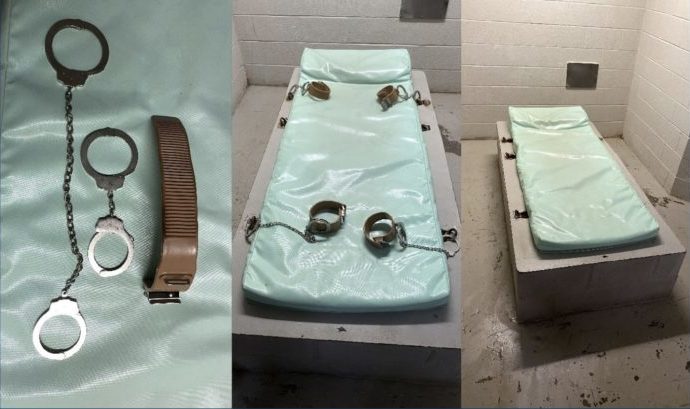(Ken Silva, Headline USA) The DOJ Inspector General’s Office published an advisory Tuesday that details how federal prison guards are chaining inmates to beds and chairs for weeks at a time, which has resulted in severe injuries and death.
Federal law allows guards to restrain inmates “only as a last alternative after all other reasonable efforts to resolve a situation have failed,” and they’re supposed to check on the inmates every 15 minutes to make sure they’re breathing and that their blood is circulating properly. According to the DOJ-OIG’s Tuesday advisory, the Bureau of Prisons (BOP) has been abusing this authority.
The DOJ-OIG said it has received dozens of complaints over the years from inmates who say they were assaulted and injured while restrained.
The examples cited by the Inspector General are horrific.
🚨NEW: A horrific new DOJ Inspector General report details how federal prison guards are chaining inmates to beds and chairs for weeks at a time, which has resulted in severe injuries and death.
For example, one inmate suffered injury requiring the amputation of part of the… pic.twitter.com/cuz8pDdKev— Ken Silva (@JD_Cashless) July 1, 2025
In one instance, an inmate had to have part of a limb amputated after being kept in restraints for over 2 days, the report said.
Another inmate appears to have been tortured to death. According to the DOJ-OIG report, that unnamed inmate was restrained for more than two days. Then, he was released for two hours—only to be pepper-sprayed and returned to his restraints for another five hours before he was found dead.
“For the inmate’s final hour in restraints before being discovered unresponsive, the 15-minute and 2-hour restraint check forms indicated that the inmate was not responding to staff,” the DOJ-OIG report noted. “According to the autopsy report for this inmate, the cause of death was ‘Vaso-Occlusive Crisis due to Sickle Cell Disease Complicating Oleoresin Capsicum Use and Prolonged Restraint Following Altercation.’”
Other inmates were placed in “ambulatory restraints”—which are defined as “approved soft and hard restraint equipment which allow the inmate to eat, drink, and take care of basic human needs without staff intervention”—for weeks on end.
“BOP records indicate that one inmate was held in ambulatory restraints for over 12 days, removed from restraints for approximately 4 hours, and then placed back into ambulatory restraints for over 30 days,” the DOJ-OIG report said.
“The BOP placed this same inmate back into restraints just about a week later, and this time held him in a combination of ambulatory and four-point restraints for more than 29 additional days.
Another inmate was placed in a combination of four-point and ambulatory restraints for more than 18 days, almost 9 days of which the inmate was in four-point restraints.”
The DOJ-OIG made a number of recommendations for the BOP to update its guidelines for restraining prisoners, and to ensure such guidelines are followed. The BOP agreed with the recommendations.
Tuesday’s advisory follows a report the DOJ-OIG issued in December 2023 about guards placing inmates in 3-feet-wide by 3-feet-long cages for hours on end.
“For approximately eight hours, the inmate stood in the secure enclosure, which did not contain a chair or any furnishings. The inmate then agreed to be handcuffed in order to receive a chair and be taken to the bathroom,” that report said.
Good Lord, I was browsing through IG reports last night and came across this
Story here: https://t.co/ciCr0o5kT1 pic.twitter.com/wiPHovD1IF— Ken Silva (@JD_Cashless) December 22, 2023
“After the inmate used the bathroom, staff returned the inmate to the secure enclosure, with a chair, rather than his standard cell due to miscommunication or lack of communication among BOP officials. The inmate then remained in the holding cage with a chair for an additional twelve hours,” he said.
“At one point during those twelve hours, the chair was removed. In addition, while the inmate may have been offered the opportunity to be handcuffed to use the bathroom again, he did not use the bathroom during the final twelve hours in the secure enclosure.”

